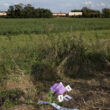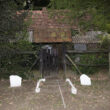Cold Trail
One of the most exciting question for me is the relationship between the sense of reality and the photograph as document. In both their narrower and wider surroundings people leave traces, some innocent, and some criminal. Reading these traces perfectly is impossible without context – words, account, testimonies, but without words every picture is a suspect. Between 2015 and 2022, I was embedded with the Hungarian police, I went to hundreds of crime scenes with the police. I have been involved in real forensics; trying to learn and do the job of a forensic technician.
The setting and technical parameters of my images are in line with the methodology that allows a photograph to become material evidence. The research and the logic of their creation follows exactly the thinking and the eyes of police professionals working at the crime scene. Image creation here is governed by strict rules because the photographs will give grounds to real judgments. I was able to participate as an observer at the Police Education Training Centre’s Crime Technician photography practice in order to be aware of the crime scene technicians’ studies from the photography image-making aspects and working methods, so that I could adhere to these as well. My NDA allowed me to review years of police photo archives. I needed the latter to familiarize myself with the aesthetics of the realized documents. My series is basically built on these two foundations.
By learning and mastering an objective and precise image capturing method, the photograph can be reconstructed as a document. It is important that the images appropriated from the police environment must not be compromised in the system of material evidence, must not depart from the nature and rules of forensic photographs, so that the aesthetics of each photograph can be further constructed, while their role as documents are enhanced. A crime scene investigation happens once and cannot be repeated. Physical evidence carries greater weight than witness accounts. Regarding my methodology, the creation of these photos exclude any fictional elements.
Szabolcs Barakonyi (1976) has exhibited his photos in several cities around the world, at photo festivals and art fairs, and in museums. These included the Chateau d’Eau in Toulouse, France and the Museum of Contemporary Art in Shanghai. He has also participated several times in the ParisPhoto through Galerie du Jour, agnés b. He has been featured at the Month of Photography in Lodz, Krakow and Paris, he has also participated in the 7th Photobiennale in Poznan, Poland, 10th Kaunas Photo Festival in Lithuania and PHotoEspaña (2014). He started his studies at The Hungarian Fine Arts University Doctoral School in 2018, he has successfully completed it in 2023.



















